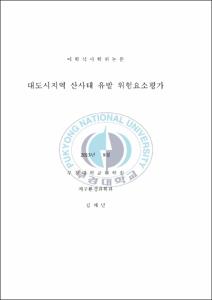대도시지역 산사태 유발 위험요소 평가
- Abstract
- Assessment on hazard factors inducing the landslides in metropolitan area
Jae Min Kim
Department of Earth Environmental Sciences, The Graduate School,
Pukyong National University
Abstract
With the rapidly increasing population density and development of infrastructure, the loss of life and property damage caused by landslides has increased gradually in urban area. Especially, Because Busan has high percentage of mountainous terrain among the metropolitan in Korea, it is unavoidable to develop mountainous region excessively. The objective of this study is to evaluate landslide hazard and produce the landslide hazard maps of the Mt. Hwangryeong located at center of Busan. The Mt. Hwangryoeng is located between Dongrae and Ilkwang Fault and consists of various rocks. In this study, two different methods were adopted to create landslide hazard maps. One was heuristic method and the other, a deterministic method. For the heuristic method, we applied tables for slope stability assessment proposed by NDMI (National Disaster Management Institute). These tables are comprised of checklists on soil and rock slopes. For the deterministic method, we used infinite slope analysis based on physical model considering the groundwater level. Database including the orientations and density of joints, strength of rock and engineering properties of soil is constructed through the field survey and results from previous studies. All data related to creating the thematic maps was carried out using ArcGIS 10.0. Results from using the heuristic method indicated that both soil and rock slope are evaluated from very stable to stable. Moderate stability has been partially presented along the edge of mountain. The results of deterministic method shows different results depending on groundwater level change. Most area indicated stable state in dry condition. However, when the groundwater level rise, unstable area increase due to high pore water pressure. Results from landslide hazard maps can be used to prevent damage from landslides and facilitate appropriate land use planning.
- Issued Date
- 2013
- Awarded Date
- 2013. 8
- Type
- Dissertation
- Publisher
- 부경대학교
- Affiliation
- 대학원
- Department
- 대학원 지구환경시스템과학부지구환경과학전공
- Advisor
- 최정찬
- Table Of Contents
- 목 차
List of Figures ⅳ
List of Tables ⅷ
Abstract ⅹ
1. 서 론 1
1.1. 연구배경 및 목적 3
2. 문헌조사 5
2.1. 산사태의 정의 5
2.2. 산사태의 유형분류 6
2.2.1. Varnes에 의한 분류 6
2.2.2. Hutchinson 에 의한 분류 11
2.2.3. EPOCH에서 제안한 분류 15
2.2.4. Carson 과 Kirby에 의한 분류 15
2.3. 산사태에 영향을 미치는 요소 17
2.4. 산사태 재해위험지도 제작방법 20
3. 연구지역의 특성 24
3.1. 연구지역에서의 기존연구들 24
3.2. 위치 및 지형특성 24
3.3. 지질특성 28
3.3.1. 암상분포 및 특성 28
3.3.2. 지질구조 32
3.4. 산사태 피해사례 및 발생유형 36
3.4.1. 남구 문현동 산사태 36
3.4.2. 광안동 상아아파트 산사태 36
3.4.3. 황령산 터널입구 산사태 37
3.4.4. 기타 산사태 37
3.5. 사면안정화 공법사례 40
3.6. 기존에 제작된 황령산 지역 산사태 재해위험지도 43
4. 연구방법 및 공간 데이터베이스 구축 45
4.1. 분석범위 47
4.2. 산사태 이력지도 제작 48
4.3. 지질 및 지질공학적 특성 주제도 제작 50
4.3.1. 현장암반강도시험(슈미트해머시험) 50
4.3.2. 체적절리계수 측정 53
4.4. 현장토질특성 주제도 제작 57
4.5. 지형특성 주제도 제작 57
5. 경험적 방법을 이용한 산사태 재해위험지도 제작 61
5.1. 토질사면평가 61
5.2. 암반사면평가 64
5.3. 분석결과 69
5.3.1. 토질사면재해위험지도 69
5.3.2. 암반사면재해위험지도 69
6. 결정론적 방법을 이용한 산사태 재해위험지도 제작 73
6.1. 토심추정 75
6.2. 지하수위 변화에 따른 분석결과 77
6.2.1. 완전히 건조한 경우 (m=0) 77
6.2.2. 지하수위가 20% 찬 경우 (m=0.2) 79
6.2.3. 지하수위가 40% 찬 경우 (m=0.4) 81
6.2.4. 지하수위가 60% 찬 경우 (m=0.6) 83
6.2.5. 지하수위가 80% 찬 경우 (m=0.8) 85
6.2.6. 완전 포화된 경우 (m=1) 87
6.3. 지하수 조건 별 결과 비교 및 요약 89
6.4. 산사태 재해 위험지역 분석결과 91
6.5. 경험적 분석과 결정론적 분석의 결과비교 93
6.5.1. 토질사면 93
6.5.2. 암반사면 93
7. 결론 및 제언 95
참고문헌 98
부 록 105
- Degree
- Master
- Appears in Collections:
- 대학원 > 지구환경시스템과학부-지구환경과학전공
- Files in This Item:
-
-
Download
 대도시지역 산사태 유발 위험요소 평가.pdf
기타 데이터 / 9.11 MB / Adobe PDF
대도시지역 산사태 유발 위험요소 평가.pdf
기타 데이터 / 9.11 MB / Adobe PDF
-
Items in Repository are protected by copyright, with all rights reserved, unless otherwise indicated.